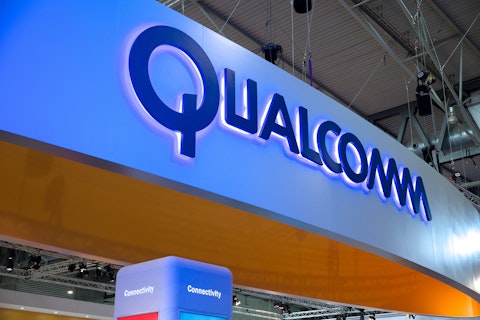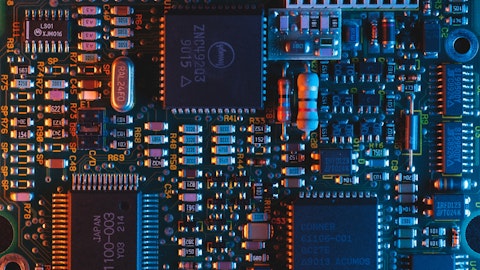QUALCOMM Incorporated (NASDAQ:QCOM) Q3 2023 Earnings Call Transcript August 2, 2023
QUALCOMM Incorporated beats earnings expectations. Reported EPS is $2.59, expectations were $1.81.
Operator: Ladies and gentlemen, thank you for standing by. Welcome to the Qualcomm Third Quarter Fiscal 2023 Earnings Conference Call. [Operator Instructions] As a reminder, this conference is being recorded, August 2, 2023. The playback number for today’s call is (877) 660-6853. International callers, please dial (201) 612-7415. The playback reservation number is 13739729. I would now like to turn the call over to Mauricio Lopez-Hodoyan, Vice President of Investor Relations. Mr. Lopez-Hodoyan please go ahead.
Mauricio Lopez-Hodoyan : Thank you, and good afternoon, everyone. Today’s call will include prepared remarks by Cristiano Amon and Akash Palkhiwala. In addition, Alex Rogers will join the question-and-answer session. You can access our earnings release and a slide presentation that accompany this call on our Investor Relations website. In addition, this call is being webcast on qualcomm.com, and a replay will be available on our website later today. During the call today, we will use non-GAAP financial measures as defined in Regulation G, and you can find the related reconciliations to GAAP on our website. We will also make forward-looking statements, including projections and estimates of future events, business or industry trends or business or financial results.
Actual events or results could differ materially from those projected in our forward-looking statements. Please refer to our SEC filings, including our most recent 10-K which contain important factors that could cause actual results to differ materially from the forward-looking statements. And now to comments from Qualcomm’s President and Chief Executive Officer, Cristiano Amon.

Kārlis Dambrāns/Flickr
Cristiano Amon: Thank you, Mauricio, and good afternoon, everyone. Thanks for joining us today. In our fiscal Q3, we delivered results consistent with our guidance with non-GAAP earnings of $1.87 per share, above the midpoint of our guidance. We recorded fiscal Q3 non-GAAP revenues of $8.4 billion, including $7.2 billion from our chipset business and $1.2 billion from our licensing business. This quarter also marked our 11th straight quarter of year-over-year double-digit percentage growth in QCT Automotive revenues. We are pleased with our technology, product and design win execution, positioning us well for continued leadership enhancements and future growth and diversification in automotive and IoT. I will now share some highlights from across the business.
Our Snapdragon Series mobile platforms continue to set the benchmark for premium tier mobile experiences. Smartphones powered by our Snapdragon 8 Gen 2 represent the top devices according to Antutu benchmarks in Android Authority. We are also pleased that the Snapdragon 8 Gen 2 for Galaxy will again power Samsung’s newest flagship device lineup globally. The Galaxy Z Flip, Galaxy Z Fold 5 and the Galaxy Tab S9 series. Our fastest Snapdragon ever for Samsung defines a new standard in smartphone computing capabilities AI experiences, desk top-level gaming features, professional-grade photography, enhanced mobile productivity and more. This launch underscores Qualcomm and Samsung’s mutual commitment to delivering premium consumer experiences for flagship Galaxy devices.
We are extremely proud of our successful partnership with Samsung Mobile. We are also pleased to extend Snapdragon experiences to mass market 5G smartphones. The redesigned Snapdragon for Gen 2 mobile platform will bring premium experiences at reduced prices to help drive 4G to 5G migration, especially in new 5G deployments worldwide. We’re looking forward to device announcements in the second half of 2023. In automotive, we hosted our first Automotive Summit in Suzhou, China, with more than 1,000 automotive OEMs, Tier 1s, ecosystem partners, media, analysts and government officials in attendance. The broad participation at the event demonstrates Qualcomm’s strong position as a technology partner to the growing automotive ecosystem worldwide, especially EVs as well as Snapdragon digital chassis technology and product leadership.
We also won more than 10 new designs with leading automakers across the globe for next-generation digital cockpit and telematics systems. In Consumer IoT, the recently announced Meta Quest 3 is the first virtual and mixed reality headset to be powered by a next-generation Snapdragon XR platform developed in collaboration with Meta — the Quest 3 features 2x the graphical performance, higher resolution and a slimmer, more comfortable form factor than the Quest 2. We’re also helping to drive the growing ecosystem of VR and MR developers in China. Oppo recently announced their Oppo MR Glass Developer Edition, powered by Snapdragon XR2. And in compute, our next-generation PC platform with integrated custom Orion CPUs in a significantly upgraded AI engine remains on track for commercial readiness.
We look forward to sharing more information at our Snapdragon Summit in October. In networking IoT, we continue to gain momentum with WiFi 7 customer design wins. As an example, TP Link expanded its retail small and media business lines by launching 5 new routers spanning indoor and outdoor deployment scenarios, all based on Qualcomm networking Pro WiFi 7 platforms. Lastly, we’re very pleased to share that we have begun shipping our fixed wireless access solutions in support of Reliance deals upcoming 5G FWA service in India. In industrial IoT, we launched a video collaboration platform suite, which provides OEMs choice and flexibility for the design and deployment of immersive video conference devices across conference rooms, health care settings and at home video calling with friends and family, enabling Windows, Android and Linux on our platforms offers the ability to customize and deploy videoconferencing products across diverse environments.
Additionally, our platforms offer industry-leading AI-based noise suppression and dynamic framing. We also launched the QCS 8550 and QCS 4490, our first software-defined IoT solutions at Hannover Messe. These solutions enable next-gen smart cameras, drones, robotics, cloud gaming, industrial handhelds, panels point-of-sale devices and more. Lastly, together with Arrow Electronics, we announced a strategic collaboration to accelerate edge and AI adoption to the formation of Edge Labs, an aero center of excellence designed to help customers alleviate IoT development challenges while increasing adoption of edge AI across a variety we have an update on our progress in Generative AI since the last call. We’re very pleased and encouraged by the rapid acceleration of Gen AI at the edge.
This presents a significant opportunity for Qualcomm across our end markets. Use cases at the edge are evolving differently than the cloud given the inherent context, immediacy, privacy, security, application reliability and personalization capabilities available on device. For example, in handsets, models such as Stable Diffusion and Control Net or changing user experiences for content creation and photography. Large language models embedded in the user interface can also enable enhanced virtual assistance. In personal computing, real-time copilots can bring significant enhancements to productivity and creativity, the benefits of which are well understood and very compelling for enterprises across industries. We believe the automotive industry will use some of the most advanced edge AI capabilities from large language models for personalized and curated content and services driver and occupant monitoring and AI virtual assistance to contextual search.
ADAS and autonomy applications can be enhanced by the fusion of data from cameras and other sensors for combined real word perception, drive path prediction and more. We’re helping enable this capabilities and expect Gen AI use cases to extend to XR, edge networking and industrial IoT. Within the quarter, we expanded our collaborations across the ecosystem, and we are engaged with multiple hyperscalers, OEMs and ISVs. Notably, we recently announced a collaboration with Meta on Llama 2-based AI implementations on flagship smartphones and PCs that will enable developers to create new and exciting Gen AI applications using the AI capabilities of Snapdragon platforms beginning in 2024. Together with Meta, we’re working to optimize the execution of Meta’s Llama 2 large language models directly on device.
We also announced a focused collaboration with Microsoft to scale AI capabilities and bring best-in-class AI experience to users across consumer, enterprise and industrial devices. At the Microsoft Build Developer Conference, our own device, Stable Diffusion, was showcased on a Windows on Snapdragon power laptop. We’re also working with them to enable a host of productivity-based applications with multiple large models running on the device. As part of this collaboration, our AI engine direct SDK is now available to Windows developers to easily accelerate their AI apps on Snapdragon compute platforms. This marks a significant milestone. In summary, we are uniquely positioned to help shape and capitalize on the upcoming on-device Gen AI opportunity.
Our AI technology is highly differentiated with best-in-class high-performance, low-power heterogeneous computing across our CPU, GPU and NPU. And a multibillion parameter Gen AI models run pervasively and continuously on device, we believe our NPUs unparalleled AI processing performance and power efficiency will become a requirement. We look forward to sharing more about our Gen AI capable products at Snapdragon Summit in October. Before I turn the call over to Akash, I would like to provide an update on how we are managing our business in the current macroeconomic environment. We remain focused on executing our strategy and prioritizing capital and resource allocation on our future growth and diversification opportunities. Simultaneously, we are focused on long-term operating margin targets, all while maintaining technology leadership across wireless connectivity, high performance, low power processing and artificial intelligence.
To that end, we’re taking a conservative view of the market, and we’ll be proactively taking additional cost actions to ensure Qualcomm is well positioned to deliver maximum value for stockholders in an uncertain environment. I would now like to turn the call over to Akash.
See also 15 Most Consumed Meats in the World and 30 Drunkest Cities in America
Akash Palkhiwala : Thank you, Cristiano, and good afternoon, everyone. I’ll start with our third fiscal quarter results. We delivered non-GAAP revenues of $8.4 billion and EPS of $1.87, which was above the midpoint of our guidance. QTL recorded revenues of $1.2 billion and EBT margin of 66% and reflecting slightly lower-than-expected global devices. QCT revenues of $7.2 billion and EBIT margin of 24% were consistent with the midpoint of our guidance. Handset revenues of $5.3 billion reflected the industry landscape we have previously outlined. IoT revenues increased 7% sequentially to $1.5 billion, driven by consumer and industrial IoT customers. We saw continued momentum in automotive for our Snapdragon digital chassis products with revenues of $434 million, a growth of 13% year-over-year.
Non-GAAP operating expenses were flat sequentially at $2.2 billion. We have successfully executed on our fiscal ’23 cost actions and are on track to exceed our commitment of a 5% reduction relative to fiscal ’22 exit rate. During the quarter, the sale of Veoneer’s active safety business to Magna was completed for net cash proceeds of $1.5 billion. Before turning to the fourth fiscal quarter guidance, I’ll update you on global 3G, 4G, 5G handset units and channel inventory. We continue to estimate that calendar 23 handset units will be down at least a high single-digit percentage relative to calendar ’22, reflecting the macro environment and a slower recovery in China. This forecast contemplates growth in handset units going into the holiday season.
In IoT, channel inventory remains elevated due to weaker demand driven by the broader macroeconomic conditions. Since it remains difficult to predict the timing of a sustained recovery and customers remain cautious with purchases, we continue to operate under the assumption that inventory drawdown dynamics will be a factor through the end of the calendar year. Turning to guidance for the fourth fiscal quarter. We are forecasting revenues of $8.1 billion to $8.9 billion and non-GAAP EPS of $1.80 to $2. In QTL, we estimate revenues of $1.15 billion to $1.35 billion and EBT margins of 64% to 68%, driven by a slight sequential increase in global handset units. In QCT, we expect revenues of $6.9 billion to $7.5 billion and EBT margins of 24% to 26%.
This forecast is consistent with our prior guidance of muted seasonality in QCT revenues primarily due to the timing of purchases by a modem-only handset customer. On a sequential basis, we are forecasting Android handset revenues to be roughly flat with mid-single-digit decline in IoT and low double-digit growth in automotive. Lastly, we expect non-GAAP operating expenses to be approximately flat relative to the third quarter. As we approach fiscal ’24, our revenue growth will largely depend on macroeconomic environment, global handset units and China recovery. In the first fiscal quarter, we expect 2 drivers of sequential revenue growth. QTL seasonality and handset launch by a modem-only customer. In addition, we expect a sequential decline in IoT and automotive revenues, consistent with the seasonal trend we’ve seen in the last couple of years.
As you will recall, we had previously communicated we would evaluate additional cost actions as the environment continues to evolve. Until we see sustained signs of improving fundamentals, our operating framework does not assume an immediate recovery. Given our commitment to operating discipline, we will proactively implement additional cost actions in the first half of fiscal ’24. This will be incremental to the reductions we have successfully completed in fiscal ’23. Despite these actions, we will preserve investments in our strategic priorities and position ourselves to emerge stronger as the recovery from the broader industry begins to take hold. In closing, we remain focused on executing on our vision to bring connectivity, high-performance, low-power computing and on-device generative AI to the edge.
Our guiding principles remain the same. — prioritize technology leadership, accelerate diversification and drive earnings growth to create value for our stockholders. This concludes our prepared remarks. Back to you, Mauricio.
Mauricio Lopez-Hodoyan : Thank you, Akash. Operator, we are now ready for questions.
Q&A Session
Follow Qualcomm Inc (NASDAQ:QCOM)
Follow Qualcomm Inc (NASDAQ:QCOM)
Operator: [Operator Instructions] The first question is from Matt Ramsay with TD Cowen.
Matt Ramsay : Akash, I guess for my first question, you were kind enough to give us a little bit of color in your prepared script just now on December and went through a few things there pretty quickly. So I wanted to double-click on a few. Maybe you could recap for us, just the trends you expect in handsets versus IoT and auto that you gave. And in particular, you talked about some seasonality being better in the fourth calendar quarter in the handset market, but that inventory burn was still going to be part of the dynamic. So if you could talk through that in a little bit more detail, what kind of magnitude are you expecting for the industry in the fourth quarter? What’s built into your estimates? And is the inventory burn just an Android dynamic? Or do you think that the prepurchases from Cupertino are still an effect in the December quarter?
Akash Palkhiwala : Sure, Matt. So there was a lot in there. I’ll try to unpack it. Let me divide it into parts. So first, starting with the market. Our forecast does assume sequential growth into the December quarter as we go into the holiday season. From a financial perspective, consistent with historical years, we typically have 2 significant drivers of growth going into December from September. First is QTL, and we expect to see that growth as the market grows as well. And then second is handset launched by a modem-only customer. Off of the base we have in September, we expect to see that growth as well. So those would be the 2 significant growth drivers into the quarter. From an IoT and automotive perspective, if you look at the last couple of years, we’ve seen a trend of a slight decline in both areas quarter-over-quarter from September to December.
So we just think the same seasonality will play out, not something that goes beyond that. It’s just a normal timing that we’ve seen in the market in the past. Maybe the last comment I’ll say is our forecast for September and December quarter does assume no material revenues from Huawei. As you are aware, we have a 4G license for shipping into Huawei. We do not have a 5G license, and we are not assuming any material revenue going forward. So hopefully, that covers all the different parts.
Operator: The next question is from Samik Chatterjee with JPMorgan.
Samik Chatterjee : I have a couple, but maybe Akash, if we can start with the calendar fourth quarter comment that you just had. If I look back at some of the seasonality that you had in prior years there. We see a wide range. I mean somewhere between sort of 10% plus to somewhat of a higher number as well in the double digits. Maybe if you can give us a bit more color in terms of — as you think about, you said in your smartphone outlook as well a recovery in the December quarter in terms of volumes. How are you thinking about it relative to typical seasonality in the prior years?
Akash Palkhiwala : Yes. So Samik, maybe no additional comments to what I just said. I think if you look at our history, with the growth in the smartphone market, we see QTL grow with it. And so we expect a similar gain this year. And then I’d probably say similar to on the modem customer side as well, we’d see something similar to what we’ve seen in the past. So I think using historical trend as a way to model it going forward is a reasonable way of doing it for those 2 factors.
Samik Chatterjee : Okay. Okay. And for my follow-up, I mean, obviously, the inventory on the balance sheet did come down a bit, but how are you thinking about the opportunity here to sort of discount to clear some inventory of the balance sheet or even sort of from an investor’s perspective or how should we think about the risk about inventory write-down if the recovery is sluggish for a period of time? How should we think about those drivers given that the inventory drawdown has continued for a longer-than-expected duration?
Akash Palkhiwala : Yes. So Samik, obviously, our analysis is reflected in our results. We think you will understand the drivers that got us to the industry, the inventory balance. It’s the overall industry being weaker. And with 6 months lead time, you’re planning for a different market. And what we’re comfortable with is that we have the inventory on the right parts. There is long lifetime on it, and there’s demand for it. So our latest analysis on the topic is reflected in our results.
Operator: The next question is from Mike Walkley with Canaccord Genuity.




